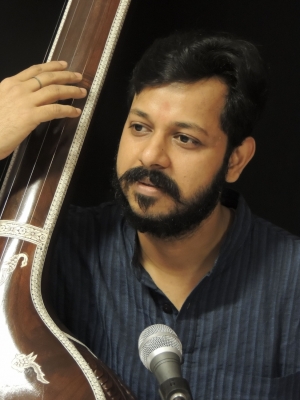By Siddhi Jain
New Delhi– A science graduate with degrees in advertising and management, Sumeet Anand Pandey is also a promising Dhrupad artist devoted to propagating a centuries-old classical tradition that has conquered the test of time and eras and to those who seek to quench their palette with the ragas and alaps of Dhrupad music.
The Dhrupad vocalist has recently launched his debut album, ‘Morning Meditation’ in Darbhanga Dhrupad tradition online.
Hailing from a revered Dhrupad Gharana, and as the tenth generation singer of Darbhanga Dhrupad tradition, Sumeet went online in order to connect the youth of the nation with their rich cultural heritage.
The album is launched on Naxos World (now part of ARC Music, UK) and available for online streaming on leading platforms. Excerpts from a chat with Sumeet:
Q. Please share with us your understanding of the Dhrupad tradition, and what pulled you to it?
A. Dhrupad is the ancient most north Indian classical music, still in practice. Its origin is inspired by vedic chanting and further based on chhanda-prabandha style from the 13th century. Devotional and meditative in nature, many ancient compositions of Dhrupad are religious and spiritual in nature with Sanskrit text. More recently, as Dhrupad traveled from holy temples to royal courts and now public performance arena, stylistic temperament also evolved alongside. Newer compositions of Braj bhasha were added. Only a few families have carried forward the rare art form Dhrupad in true Guru-Shishya tradition, of which Darbhanga Mallick tradition’s role is pivotal. They specialise in Gauhar vani tracing their origin to Tansen’s Senia lineage and also have a healthy repertoire of Khandar vani. I was born in Darbhanga Dhrupad family as maternal grandson of one of the greatest vocalist, Padma Shri Pandit Siyaram Tiwari, thus got exposure to music from an early age.
Q. In today’s music space, what do you think keeps Indian classical music relevant?
A. Indian classical music is based on hundreds of years of collective research and wisdom of scholars and saints of ancient India. It is a rich and vast field with unparalled combination of both art and science. This makes it an ocean of sorts which has some thing to offer to anyone and everyone who wishes to study and practice music, irrespective of their genre or specialisation.
Q. Please tell us about your artistic legacy and tutelage. What made you give up career prospects in science and advertising for this?
A. After my childhood training under both my grandfathers, Shri Birendra Mohan Pandey and Pandit Siyaram Tiwari, I came under the tutelage of my present Guru Pandit Abhay Narayan Mallick, grandnephew and master disciple of Padma Shri Pandit Ram Chatur Mallick. I trained with him continuously for over a decade and continue to receive his guidance from time to time. I felt an undescribable and irresistible pull towards Indian classical music, and particularly Dhrupad when I was learning from Pt. Mallick. I also sensed the unfathomable depth of this artform and understood the need to wholeheartedly commit myself to it if I was serious about getting anywhere close to taste the real nectar. Hence, the hard decision of quitting a safe and lucrative career in marketing for an uncertain and arduous journey in music became the obvious choice.
Q. You’re also a festival curator and organiser. What do you think are the key hits and misses of classical performers’/festivals’ approach to the common person?
A. There are many things to improve in the classical music festival scene as well as classical performances. My discomfort with Entry-Free culture led me to start Geetam Vadyam Nrityam, a festival that presents the three disciples, namely vocal, instrumental and dance in a single evening format for a nominal support fee. This initiative particularly focuses on young and promising talent. Young artists need to showcase their talent and at the same time be paid for their efforts in simple terms. Likewise, art and culture organisations need to look beyond big crowd pullers name only and focus on presenting younger artists to people as well. Performers also need to look beyond just programs and invest their time and energy in inculcating appreciation and awareness about Indian classical music among masses, particularly young students and professionals. Well produced online lecture-demonstrations, art appreciation courses, workshops etc. should be organised in an easy to understand manner to reach a wider audiece and dispel myths around our classical music which do more damage than good. In the times of pandemic, one has to leverage digital and online medium and learn new skills to stay relevant.
Q. What is the thought behind ‘Morning Meditation’? How did it come about?
A. Morning Meditation, my debut Dhrupad album, as the title suggests, has morning raga Ahir Bhairav as the main track. An extended Dhrupad alap in Darbhanga Dhrupad style followed by a composition set to choutal, ‘Shyam Sundar ko Pratah Samay’ takes listeners into a meditative and spiritual state. Additional track is an uplifting sargam ki Bandish in raga Bhairav set to sooltal. The album actually came about as a lucky coincidence during my Dhrupad recital in Berlin in 2019. Naxos World (now ARC Music) record label’s A&R manager was in the audience, who approached me after the recital and invited for a meeting the next day to discuss work. To my pleasant surprise, an album was offered in that meeting and subsequently recorded in Delhi and mastered in the UK. (IANS)














